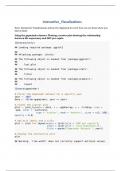International Business Context
University of Amsterdam
Exam Document
Contains:
Learning questions (headers)
Answers (bullets)
For every week.
, Theme 1: Context
1. According to Buckley et al. (1976), why multinational enterprises (MNEs) is created
and expanded? Among 4 main groups of factors which are relevant to the
internalization decisions (P33), which of them could be the contextual factors?
Why?
a. Buckley et al. (1976) use the internalization theory that considers
imperfections in markets for intermediate products and suggests that MNEs
internalize these markets to increase profits by bringing activities under
common ownership and control. According to the Transaction Cost
Economics (TCE) approach, internalization is recommended when the costs of
doing business at arm's length are higher than costs of internalization. Thus,
Buckley takes a TCE approach to internalization, studying various factors
influencing the transaction costs.
b. Internalization is important for dynamic innovation processes regulated by
intermediate products and thus MNEs expand their boundaries to internalize
markets of knowledge and maximize profits. Four main groups of factors
relevant to internalization decision are i) Industry-specific factors that define
product characteristics and external market structure, ii) Region-specific
factors define geographical and social characteristics, iii) Nation-specific
factors define political and fiscal conditions, and iv) Firm-specific factors that
reflect the management’s ability to organize internal markets (Buckley et al.
1976).
c. All the factors, except firm specific ones, are contextual in the sense that they
define the boundaries of the firm and its interaction with the external
environment. Industry-specific factors are concerned with knowledge
production, expansion and influences of the industry on firm’s boundaries.
Region- and nation-specific factors are linked to the institutional
environment, trade laws and barriers, local practices which are influenced by
culture and social norms.
2. According to Narula et al. (2019), how do Hennart stream and Rugman stream
contribute to Buckley’ internalization? Are these contributions part of business
context? Why?
a. Narula et al. (2019) argue that Internalization theory (IT) has devolved into
distinct, but partly overlapping ‘streams’, being flexible in absorbing
complementary concepts. The streams relating to Buckley and Hennart
regard IT as a theory with clear assumptions allowing specific, parsimonious
propositions. One of Hennart’s contributions to IT consists of adding types of
transaction costs anchored in bounded rationality and opportunistic market
behavior. Another one is his conceptualization of the ‘swollen middle’.
Hereby, he moves analytical focus from overseas deployment of MNE’s assets
to a cross border bundling of complementary assets. Rugman expanded IT
through more firm-specific considerations of resource characteristics, which
led to deepening linkages with the Resource-Based View and the
development of FSA fungibility. differentiates between methods for
organizing transactions and institutions, arguing that it adds more value to
2
University of Amsterdam
Exam Document
Contains:
Learning questions (headers)
Answers (bullets)
For every week.
, Theme 1: Context
1. According to Buckley et al. (1976), why multinational enterprises (MNEs) is created
and expanded? Among 4 main groups of factors which are relevant to the
internalization decisions (P33), which of them could be the contextual factors?
Why?
a. Buckley et al. (1976) use the internalization theory that considers
imperfections in markets for intermediate products and suggests that MNEs
internalize these markets to increase profits by bringing activities under
common ownership and control. According to the Transaction Cost
Economics (TCE) approach, internalization is recommended when the costs of
doing business at arm's length are higher than costs of internalization. Thus,
Buckley takes a TCE approach to internalization, studying various factors
influencing the transaction costs.
b. Internalization is important for dynamic innovation processes regulated by
intermediate products and thus MNEs expand their boundaries to internalize
markets of knowledge and maximize profits. Four main groups of factors
relevant to internalization decision are i) Industry-specific factors that define
product characteristics and external market structure, ii) Region-specific
factors define geographical and social characteristics, iii) Nation-specific
factors define political and fiscal conditions, and iv) Firm-specific factors that
reflect the management’s ability to organize internal markets (Buckley et al.
1976).
c. All the factors, except firm specific ones, are contextual in the sense that they
define the boundaries of the firm and its interaction with the external
environment. Industry-specific factors are concerned with knowledge
production, expansion and influences of the industry on firm’s boundaries.
Region- and nation-specific factors are linked to the institutional
environment, trade laws and barriers, local practices which are influenced by
culture and social norms.
2. According to Narula et al. (2019), how do Hennart stream and Rugman stream
contribute to Buckley’ internalization? Are these contributions part of business
context? Why?
a. Narula et al. (2019) argue that Internalization theory (IT) has devolved into
distinct, but partly overlapping ‘streams’, being flexible in absorbing
complementary concepts. The streams relating to Buckley and Hennart
regard IT as a theory with clear assumptions allowing specific, parsimonious
propositions. One of Hennart’s contributions to IT consists of adding types of
transaction costs anchored in bounded rationality and opportunistic market
behavior. Another one is his conceptualization of the ‘swollen middle’.
Hereby, he moves analytical focus from overseas deployment of MNE’s assets
to a cross border bundling of complementary assets. Rugman expanded IT
through more firm-specific considerations of resource characteristics, which
led to deepening linkages with the Resource-Based View and the
development of FSA fungibility. differentiates between methods for
organizing transactions and institutions, arguing that it adds more value to
2










